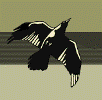Research at the Center for Avian Cognition spans a broad array of behavioral and cognitive studies, united by the view that animal intelligence is responsive to specific evolutionary and ecological demands. We pursue several lines of research, each of which combines psychological and biological perspectives.
One line of research explores the cognitive mechanisms of visual search in blue jays, and the effects of these mechanisms, particularly selective attention, on the evolution of the appearance of their prey.This research examines the effects of cognitive processes in predatory blue jays on the evolution of populations of virtual prey. Using genetic algorithms that specify the phenotypes of digital moths, we have been able to shed light on a number of evolutionary questions, such as the origin of cryptic polymorphism, that were otherwise inaccessible to experimental analysis.
A second program explores mechanisms of spatial cognition in Clark's nutcrackers and other seed-caching corvids, with an emphasis on how landmarks are used to re-locate specific sites.
A third program employing both field observations and laboratory experiments uses comparisons between related species to explore the evolution of social cognition in jays and magpies and the adaptive significance of behavioral flexibility in keas and kakas, two species of New Zealand parrots.


